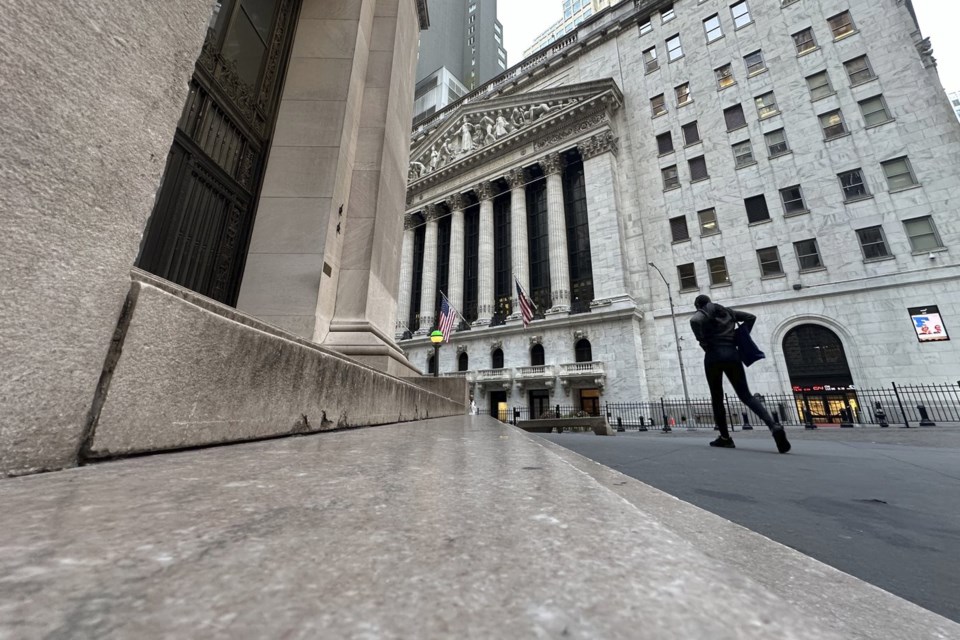NEW YORK (AP) — U.S. stocks rebounded as falling oil prices release some of the pressure that built up on the market. The S&P 500 rose 1% Tuesday and clawed back its loss from the day before. The Dow Jones Industrial Average added 0.3%, while the Nasdaq composite climbed 1.4% as Big Tech stocks led the way. Wall Street held firm even though stock markets around the world sank following scary swings in China, as euphoria about possible stimulus for the world’s second-largest economy gave way to disappointment. Stocks in Hong Kong tumbled to their worst day since 2008.
THIS IS A BREAKING NEWS UPDATE. AP’s earlier story follows below.
NEW YORK (AP) — U.S. stocks are on the rebound Tuesday as falling oil prices release some of the pressure that built up on the market.
The S&P 500 was 0.9% higher in afternoon trading and clawing back nearly all of its . The Dow Jones Industrial Average was up 123 points, or 0.3%, and likewise nearing set last week, while the Nasdaq composite was leading the way with a 1.2% gain, as of 3 p.m. Eastern time.
Wall Street held firm even though stock markets around the world sank following scary swings in China, as euphoria about possible stimulus for the world’s second-largest economy . Stocks tumbled 9.4% in Hong Kong for their worst day since the 2008 global financial crisis.
Helping to support Wall Street was a sharp drawdown in oil prices. They gave back some of the big recent gains they made on worries that could ultimately lead to .
A barrel of Brent crude, the international standard, fell 4.6% to $77.18 for its first loss in a week and a half. A barrel of benchmark U.S. crude, meanwhile, eased 4.6% to $73.57.
That also helped helped level off the pressure on the stock market from the bond market. Treasury yields were mixed, a day after they shot to their highest levels since the summer.
The 10-year Treasury yield was holding steady at 4.03%, where it was late Monday. The two-year yield, which more closely tracks expectations for what the Federal Reserve will do with overnight interest rates, slipped to 3.97% from 3.99%, late Monday, though it's still near its highest level since August.
When Treasurys are paying higher yields, investors generally become less willing to pay very high prices for stocks and other investments. And Treasury yields had been storming higher over the last week following a suite of reports showing the U.S. economy remains healthier than expected.
Such reports, including one last week showing than forecast, raise hopes that the economy will avoid a recession. But they also force traders to ratchet back expectations for how much the Federal Reserve , now that it has widened its focus to include instead of just .
Traders have abandoned expectations for the Fed to cut its main interest rate by a larger-than-usual half of a percentage point at its next meeting, for example. Instead, they’re largely betting on a traditional-sized cut of a quarter of a percentage point, according to data from CME Group. Some are even betting on a small possibility the Fed could keep its main rate steady in November.
High Treasury yields put the most pressure on stocks seen as the most expensive, and that puts the spotlight on the Big Tech stocks that have led the market for most of the last few years.
On Tuesday, all of the Big Tech stocks that have collectively come to be called the “Magnificent Seven” rose. Nvidia led the way with a gain of 4.1% and was the strongest single force lifting the S&P 500.
PepsiCo climbed 1.8% after for the latest quarter than analysts expected, though its revenue fell short.
CEO Ramon Laguarta also said the company now expects a “low single-digit” increase in an important measure of revenue for the year after it had earlier forecast growth of about 4%. U.S. consumers continue to on buying snacks and drinks after years of price increases.
On the losing end of Wall Street were oil-and-gas companies, which gave back some of their big recent gains driven by the jump in crude prices. Chevron fell 1.6% and was one of the main reasons the Dow lagged other indexes.
In stock markets abroad, trading in mainland China reopened following a national holiday. Before, indexes in Shanghai and Shenzhen had surged on hopes for stimulus from the government and the central bank meant to prop up the economy’s flagging growth.
On Tuesday, China’s economic planning agency outlined details of measures aimed at boosting the economy, but it refrained from major spending initiatives. That helped lead to the 9.4% drop for the Hang Seng index in Hong Kong.
In Shanghai, where the market had been closed as Hong Kong ran higher over the last week, stocks rose 4.6% following their reopening.
The disappointment in China had worldwide effects, knocking down stocks of companies in Europe, the United States and elsewhere that do lots of business in and around China. Estee Lauder fell 2.2%, for example, while Wynn Resorts lost 2.3%.
___
AP Business Writers Matt Ott, Elaine Kurtenbach and Zen Soo contributed.
Stan Choe, The Associated Press




